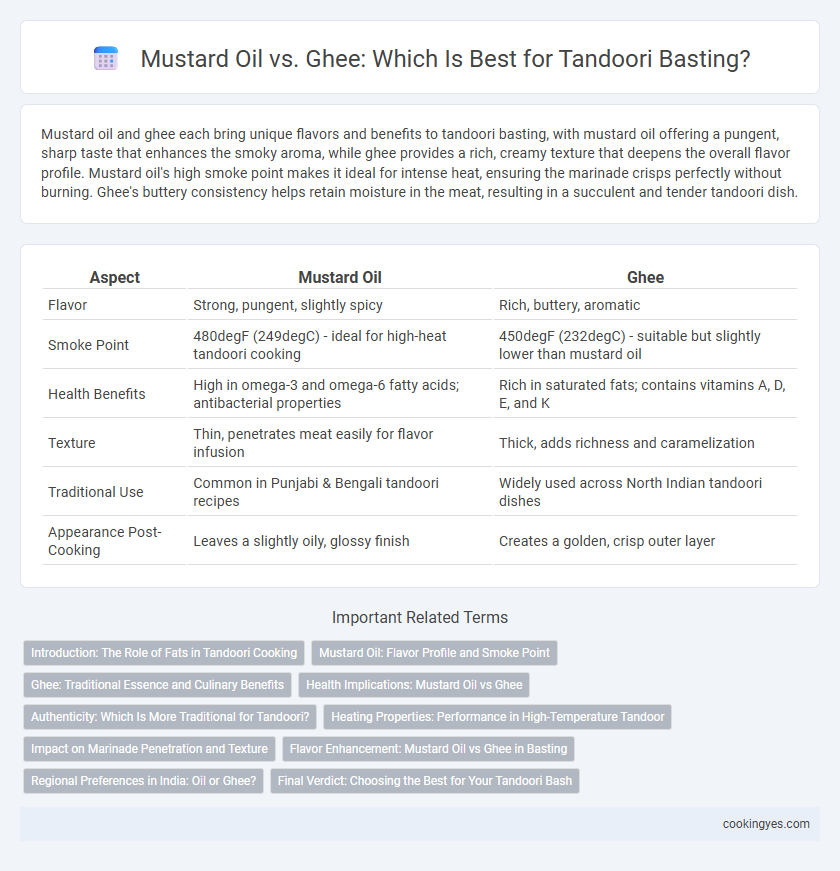Mustard oil and ghee each bring unique flavors and benefits to tandoori basting, with mustard oil offering a pungent, sharp taste that enhances the smoky aroma, while ghee provides a rich, creamy texture that deepens the overall flavor profile. Mustard oil's high smoke point makes it ideal for intense heat, ensuring the marinade crisps perfectly without burning. Ghee's buttery consistency helps retain moisture in the meat, resulting in a succulent and tender tandoori dish.
Table of Comparison
| Aspect | Mustard Oil | Ghee |
|---|---|---|
| Flavor | Strong, pungent, slightly spicy | Rich, buttery, aromatic |
| Smoke Point | 480degF (249degC) - ideal for high-heat tandoori cooking | 450degF (232degC) - suitable but slightly lower than mustard oil |
| Health Benefits | High in omega-3 and omega-6 fatty acids; antibacterial properties | Rich in saturated fats; contains vitamins A, D, E, and K |
| Texture | Thin, penetrates meat easily for flavor infusion | Thick, adds richness and caramelization |
| Traditional Use | Common in Punjabi & Bengali tandoori recipes | Widely used across North Indian tandoori dishes |
| Appearance Post-Cooking | Leaves a slightly oily, glossy finish | Creates a golden, crisp outer layer |
Introduction: The Role of Fats in Tandoori Cooking
Mustard oil and ghee play crucial roles in traditional tandoori cooking by enhancing flavor, moisture, and aroma during basting. Mustard oil contributes a pungent, sharp taste and high smoke point, ideal for retaining the tandoori's smoky char. Ghee imparts a rich, buttery flavor and crisp texture, facilitating caramelization while locking in juiciness for tender, succulent results.
Mustard Oil: Flavor Profile and Smoke Point
Mustard oil, with its pungent and slightly spicy flavor, enhances the authentic taste of tandoori dishes, adding a distinct sharpness that complements the smoky char. Its high smoke point, around 480degF (250degC), makes it ideal for the intense heat of tandoori cooking, preventing the oil from burning and imparting a bitter taste. Using mustard oil as a basting medium preserves the bold flavors while ensuring a crisp, evenly cooked exterior on meats and vegetables.
Ghee: Traditional Essence and Culinary Benefits
Ghee offers a rich, nutty flavor and high smoke point that enhances the authentic taste and texture of tandoori dishes, making it ideal for basting. Its traditional essence brings depth to the marinade, ensuring tender, juicy meat with a caramelized crust. Unlike mustard oil, ghee imparts a smooth finish and promotes even cooking without overpowering the spices.
Health Implications: Mustard Oil vs Ghee
Mustard oil contains higher levels of monounsaturated fats and omega-3 fatty acids, which contribute to better cardiovascular health and anti-inflammatory properties when used for tandoori basting. Ghee, rich in saturated fats and butyric acid, supports digestive health and provides fat-soluble vitamins but may elevate LDL cholesterol if consumed excessively. Choosing mustard oil versus ghee for tandoori cooking depends on balancing heart health benefits against nutrient density and flavor preferences.
Authenticity: Which Is More Traditional for Tandoori?
Mustard oil is considered more traditional for tandoori basting due to its strong, pungent flavor that complements the smoky notes of tandoor cooking, reflecting authentic North Indian culinary practices. Ghee, while popular in Indian cuisine for its rich, buttery taste, is more commonly used in frying or finishing dishes rather than in the high-heat basting of tandoori items. The use of mustard oil aligns with age-old recipes and regional preferences, preserving the distinctive, earthy aroma essential for authentic tandoori flavors.
Heating Properties: Performance in High-Temperature Tandoor
Mustard oil's high smoking point around 480degF makes it ideal for achieving the intense heat needed in tandoori cooking without breaking down or smoking excessively. Ghee, with a slightly lower smoke point near 450degF, provides rich flavor and caramelization but risks burning faster under prolonged high heat. For optimal performance in high-temperature tandoors, mustard oil ensures stability and crispness, while ghee enhances taste with a slightly reduced thermal endurance.
Impact on Marinade Penetration and Texture
Mustard oil's high smoke point and pungent flavor enhance marinade penetration by effectively carrying spices deeper into the meat, resulting in a sharper, more intense tandoori taste. Ghee, with its buttery richness and moderate smoke point, creates a smoother texture by coating the meat surface, promoting a tender and moist finish without overpowering the marinade's spices. Choosing mustard oil intensifies flavor absorption and crispness, while ghee offers a softer, richer texture with subtle caramelization.
Flavor Enhancement: Mustard Oil vs Ghee in Basting
Mustard oil imparts a bold, pungent flavor with its sharp, slightly spicy notes that enhance the smoky depth of tandoori dishes. Ghee offers a rich, nutty aroma and creamy texture, enriching the tandoori's mouthfeel and providing a smooth, buttery finish. Choosing between mustard oil and ghee for basting depends on whether a vibrant, robust taste or a luxurious, mellow richness is desired to elevate the overall flavor profile.
Regional Preferences in India: Oil or Ghee?
In North India, mustard oil is traditionally favored for tandoori basting due to its pungent flavor and high smoking point, enhancing the smoky aroma of tandoori dishes. Conversely, in regions like Punjab and Gujarat, ghee is preferred for its rich, nutty taste that adds depth and a buttery finish to the grilled meats. The choice between mustard oil and ghee reflects regional culinary heritage and impacts the overall flavor profile of tandoori recipes.
Final Verdict: Choosing the Best for Your Tandoori Bash
Mustard oil enhances tandoori dishes with its pungent flavor and high smoking point, making it ideal for authentic, smoky basting. Ghee adds a rich, buttery aroma and caramelized finish, improving tenderness and depth of flavor during cooking. For a bold, traditional taste, mustard oil is best, while ghee suits those seeking richness and a smoother texture in their tandoori bash.
Mustard oil vs Ghee for tandoori basting Infographic

 cookingyes.com
cookingyes.com